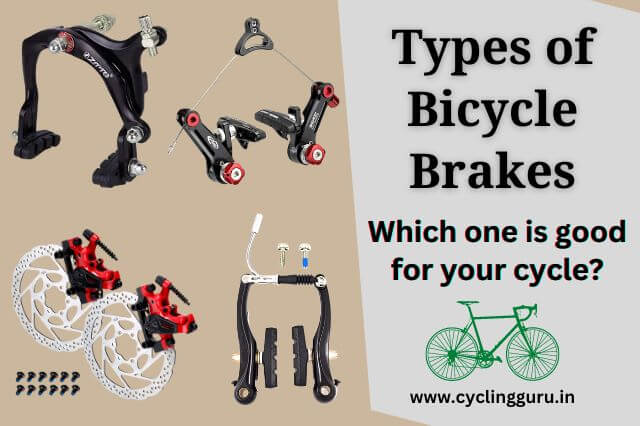You must have complete control over your bicycle when you are riding it, It’s very important for your safety and others as well. And That’s why the brakes are installed on the bicycles.
Brakes on cycles allow you to lower your pace or even stop your bicycle in a controlled way. It is worth mentioning that brakes are one of the highly vital features of a bicycle or bike.
You must have seen various types of bicycle brakes on different kinds of cycles or in the market. Have you ever thought about why are bicycles equipped with so many kinds of brakes? depending
Well, the answer is, It depends upon the type of bicycle and its price. Otherwise, The main function of every brake is to reduce the speed or even stop the bike and each has varied features that make them stand out from the rest.
Let me explain to you how do bicycle brakes work before we dive deeper into the bicycle brake types.
How Do Bicycle Brakes Work?
Brakes operate with the application of friction to the surface. While mechanical brakes use cables to activate them while hydraulic brakes use fluid to engage with their braking pads.
It is extremely important to know both of the mechanisms as It will help you to pick the best kind of brake for your bicycle to match your form of riding:
How do mechanical brakes work on a bicycle?
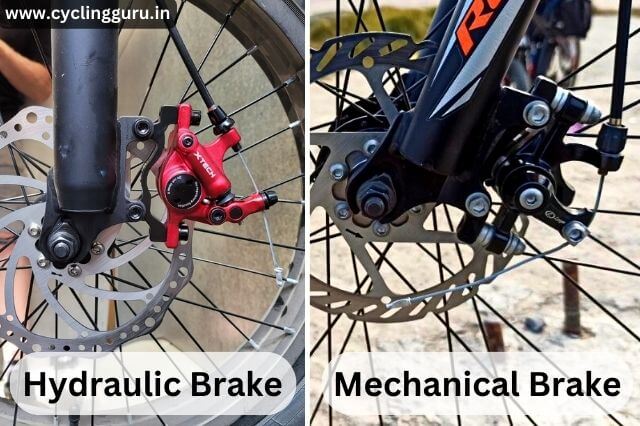
Whenever a cyclist pulls a mechanical bike brake, the brake lever starts pulling the cable causing the calliper to get pulled and stiffened. After it gets tightened, the braking pads of the calliper apply friction to the brake’s surface, helping slow down the bike and bringing it to a halt.
How do hydraulic brakes operate on a bicycle?
When a cyclist engages their hydraulic brake lever, the lever imposes greater pressure on the hydraulic fluid that sits within the airtight braking hose. The compressed braking fluid causes this calliper to tighten and the brake pads apply greater friction onto the braking surface that slows down the bike stopping it.
When it comes to mechanical disc brakes vs hydraulic disc brakes. Hydraulic is more effective than mechanical brakes. We will also cover various forms of bike brakes available in the market.
So, continue scrolling down to find out the types of brakes in bicycles that match your riding style.
Different Types of Bicycle Brakes
You will normally come across 5 main kinds of bike brakes including the disc, coaster, rim, and drum brakes. Generally, the disc brakes and the rim brakes are mainly considered highly popular ones and are used commonly. Each offers a distinctive set of benefits, compatibility, and features distinct among the cycling disciplines.
1. Rim Brakes: How do rim brakes work in bicycles?
As the name indicates, the rim brakes use the wheel’s rim as their braking surface. The calliper attaches to the fork or the frame with brake pads that squeeze the rim whenever you press the brake levers.
Rim brakes are often seen on road bikes, cheap mountain bikes, and hybrid and city bikes. You can often find the rim brakes on road bikes, a few hybrids, cheaper mountain bikes, and city bikes.
But, Rim brakes are one of the best types of brakes on road bikes thus, more and more road bikes are arriving with bicycle rim brakes. It comes with two common subtypes that include the cantilever and calliper brakes. Here are the types of rim brakes in bicycles:
a. Caliper brakes
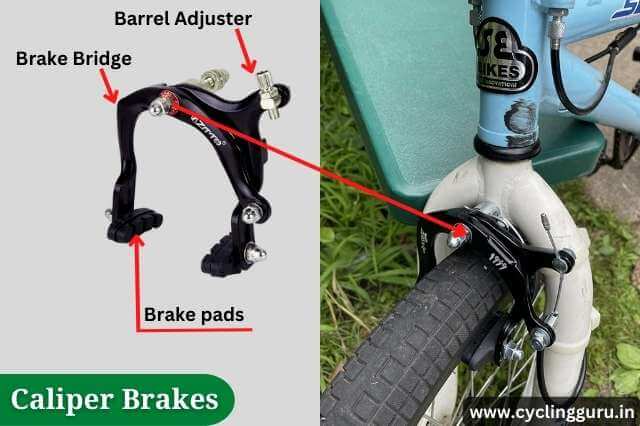
The Caliper brakes are commonly found among road bikes mainly on the higher-end lightweight models and the cheaper ones.
They mainly attach themselves to the fork or the bike’s frame through a single bolt activated with a cable. There are a few hydraulic models; however, they are quite rare. Additionally, added to the variety of the single-bolts, the direct-mount calliper brakes use two bolts that are rising in popularity too.
Related: Best ranger cycles with caliper brakes
b. Cantilever brakes
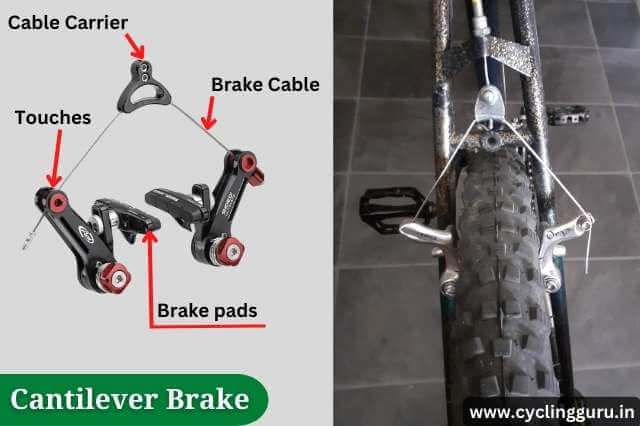
These cantilever brakes are used in the common cyclocross Bikes however they are eventually getting replaced by bicycle disc brakes due to their premium performance in muddy and wet conditions. The centre-pull cantilever brakes have two braking arms attached on either end of the wheel with the centrally lined cable that gets pulled upwards whenever the brake lever gets pressed.
c. V-Brakes
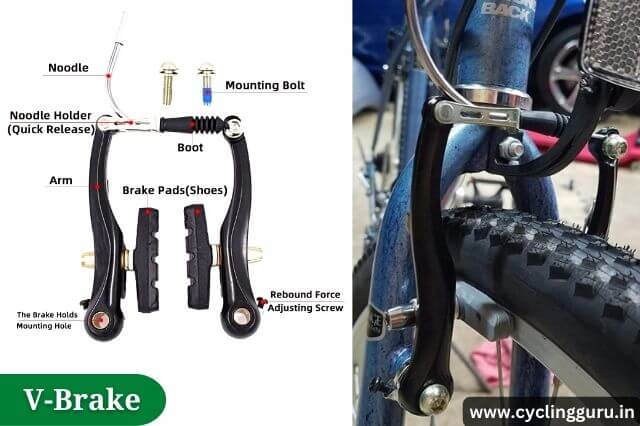
The V-Brakes are yet another common subtype of the rim brakes installed on affordable city bikes, hybrids, touring bikes, and cheap MTBs. These V-Brakes have both their brake arms attached to either end of the rim; however, the cable gets mounted on one side, imposing a direct pull instead of the centre pull.
It means that a single arm gets pulled toward the rim while the other arm gets pushed toward it. Both arms get pulled towards the rim with a centre-pull variety.
These V-brakes are cheaper, simple, and offer decent stopping power for daily rides around the city. But, they are not the favourite choice of ride in terms of performance bikes due to their subpar braking and modularity compared to other types of bicycle brakes.
Related: Best bicycles with v brakes
d. U-Brakes

The U-Brake is the variation of the rim brake commonly found on old-school mountain bikes and BMX bikes. It is worth mentioning how they work as they are a blend between the cantilever and calliper brakes.
They comprise two L-shaped brake arms mounted on both sides of the wheel that lies above the rim and crosses above the tire. These are the arms pulled together by the cable line from the side or the straddle wire carrier that gets pulled by the brake cable.
2. Disc Brakes: How do disc brakes work in bicycles?
While checking out the different types of brakes in cycles, disc brakes have become the new norm these days. A couple of years back, bicycle disc brakes appeared only on mountain bikes that use performance. But, these days they have turned out as the golden standard which is installed across different forms of bicycles, even on some road bikes.
Disc brakes are the most powerful brakes in bicycles as they offer ideal braking performances and greater modularity than other forms, especially in riding conditions. Their superiority is obvious in the wet weather; however, their weight keeps the weenies off the road.
Further, disc brakes get divided into hydraulic and mechanical subtypes, although both have identical bicycle brake parts and work identically.
The bicycle brake calliper is attached to the fork or the frame, which squeezes the steel disc or the rotor that bolts to the wheel positioning between the brake pads within the calliper.
a. Mechanical Disc Brakes
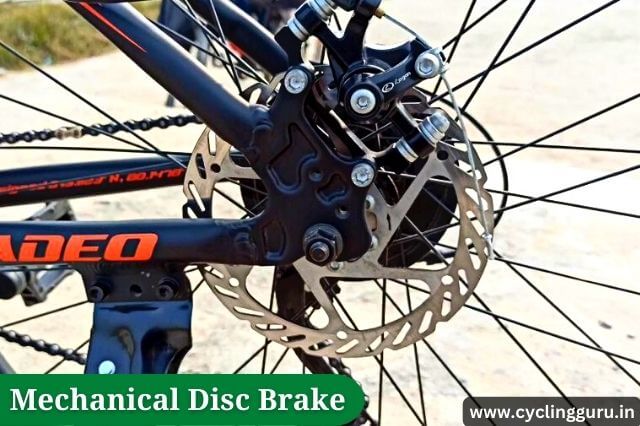
Mechanical disc brakes are even known as the cable-actuated bike disc brake. It utilises a steel cable to activate the calliper and apply the braking potential.
These brakes attain a lot of negative reputation since they are heavier and involve the rider squeezing the levers harder to avail a better stoppage potential. But, they are cheaper than the hydraulic kind, which is why they are often witnessed on affordable bicycles.
The mechanical disc brakes are highly complex to adjust, leading to rotor rub issues with a couple of affordable models having worse braking performances than rim brakes.
Related: Best bicycles with mechanical disc brakes
b. Hydraulic Disc Brakes

The hydraulic disc brakes use a completely sealed hose filled with the hydraulic braking fluid instead of the cable. When pressing the brake lever with the fluid inside the braking system, it compresses and even activates the bike brake calliper pushing the brake pads towards these rotors.
The hydraulic disc brakes are much better than the mechanical ones in almost every regard. They have better stoppage power and great modularity and are even easier to adjust; however, they come at higher prices.
The only downside to the disc brakes is that the braking system needs occasional bleeding to remove the air bubbles. It gets messier and involves some special tools allowing several riders to take their bikes for periodic or regular maintenance.
3. Coaster Brakes

The coaster brakes are only seen on single-speed cruisers and city bikes. These are the easiest ones to use and involve zero maintenance.
Each part of the coaster brakes is sealed within its rear hub, and they get activated by pressing the pedal backwards and pushing the brake shoe against the rotating mechanisms within the rear hub. In this way, the hub can never rotate, and the bike starts slowing down and coming to a halt.
Although the coaster brakes are cost-effective and versatile, they do not offer sound modularity and easily lock onto the rear wheel. As an outcome, the tire skids, thereby reducing the braking performance and stretch the braking distance.
4. Bicycle Drum Brake
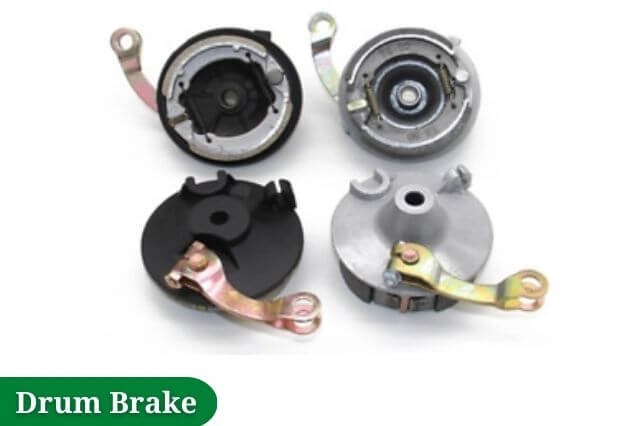
There are drum brakes in bicycles too, It is a form of a hub brake that remains at the core of the wheel using the internal brake shoes applying greater friction onto the outer drum, thereby reducing the speed and stopping the bike.
The drum brakes are the prominent kind of brake used by automobiles and were even a common sight on bicycles around the world, which was invented in 1902. These days, drum brakes are never found on new bikes since disc, and rim brakes have become the new norm due to their ease of maintenance and reliability.
Disc Brakes Vs Rim Brakes: Which Brake is More Effective?
What do you know about the difference between disc and rim brakes in detail? It is the common query asked by the riders who cannot decide between the two. Our major rundown of the massive distinctions below will help you make your choice that meets your distinctive requirements.
1. Braking Power
The bicycle disc brakes generate great potential for the braking system compared to the rim brakes. The primary reason is that the brake pads on the disc brakes are noted to have a wider surface while squeezing the rotor with greater force. They even easily stop the bike on a dime, even in damp and wet weather.
Furthermore, since a disc brake has more stopping power than a rim brake, you require less strength of your hand to activate the bicycle brake callipers, slowing down and even stopping your bike.
2. Modulation or Control
The disc and the rim brakes differ significantly in control or modulation. It is the term referring to how well you are controlling the amount of braking power you wish to apply to the callipers.
It is easier for the lighter, harder, or anything between the pressure on and the disc brakes than the rims brakes. As an outcome, you will have better control of your speed whenever you are descending or cornering, which is essential while making this move.
3. Weight
It’s true that disc brakes have greater potential. However, they weigh a few hundred grams more than the rim brakes on average. It might not be a huge issue, especially for recreational riders; however, it is mainly for performance-oriented cyclists and climbers.
However, it still does not prevent professional cyclists in their Grand Tour Pelotons from using these disc brakes, irrespective of their weight drawback. If you consider a difference of about 200 to 300g, it will make or even break your ride, which is why it is important to pick the rim brakes.
4. Price
The rim brakes are quite less expensive than bicycle disc brakes. Disc brakes are highly complex, which is quite true for hydraulic disc brakes, which come at higher costs. It is the only reason behind several affordable road and hybrid bikes that feature rim brakes instead of disc ones.
If you have budget issues, the high-end rim brakes will offer you greater braking power and last longer than any other cheaper disc brakes.
5. Weather Resistance
Finally, the other significant difference between these two forms of bike brakes has a lot to do with the reliance on the weather as it can withstand the wrought of nature. Generally, disc brakes are highly reliable in wet weather, muddy conditions, and snow compared to rim brakes.
If you are riding in wet conditions frequently or riding off the road along a muddy trail, then a good pair of hydraulic disc brakes will create a world of difference here.
Related: How to Prevent Cycle Theft in India? – 7 Best Ways to Prevent
Frequently Asked Questions: Types of Bicycle Brakes
-
Why don’t road bikes have disc brakes?
Most road bikes don’t have disc brakes as it is the most powerful braking system in bicycles, it stops the bike instantly when applied. Road bikes won’t be able to control their speed if disc brakes are installed and applied because they are very lightweight, have thin tires with low traction on roads, and run at very high speeds on roads.
-
Why are rim brakes not better than disc brakes?
The mechanism of rim brakes is to stop the rims using the brake pads and it’s become tough when rims are wet due to rain or muddy surface. Whereas, disc brakes stop the rotor using disc pads which are located at the centre of the wheel.
Conclusion: Different Types of Brakes in Bicycles
If you have covered our guide today, highlighting the varied brakes available for bikes, then we hope that the information is enough for you to choose a suitable brake type for your bicycle accordingly.
I hope, You have got a better understanding of the types of bike brakes that are suitable for the cycling disciplines you are pursuing, along with being able to carry out the important brake routine checks and maintenance.
Before you go, You should also read:
If you find this article helpful, share your thought in the comment section below. Do share this blog with your friends.

